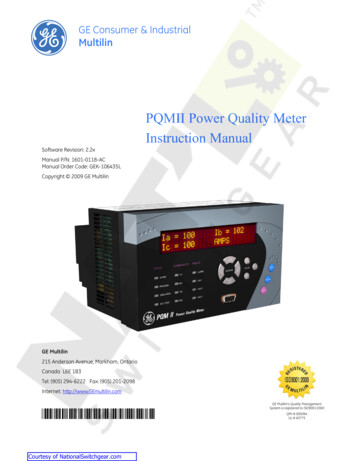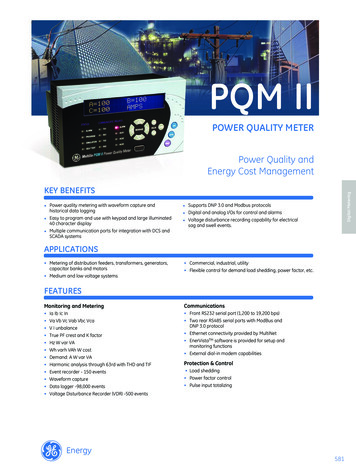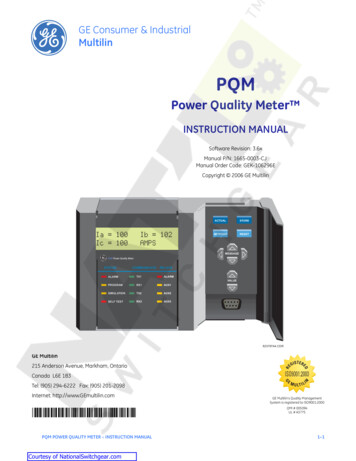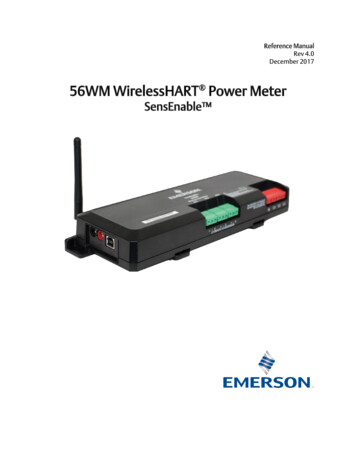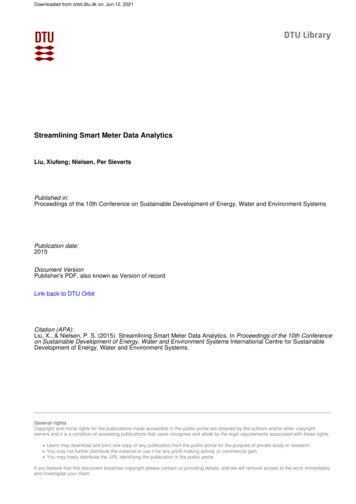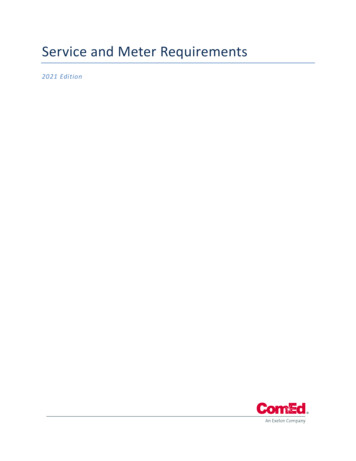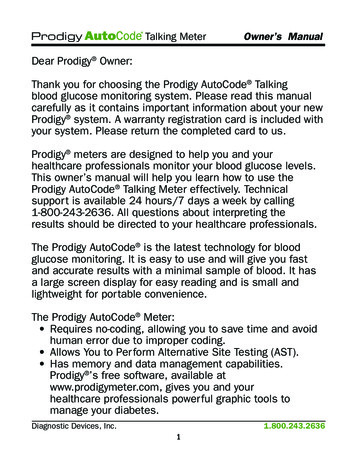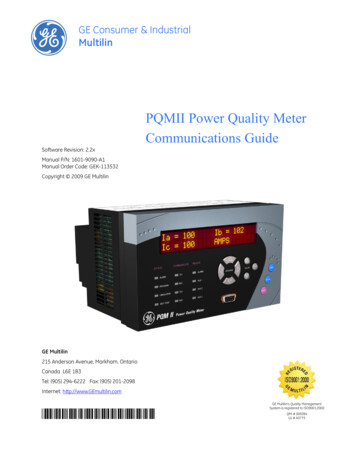
Transcription
GE Consumer & IndustrialMultilinPQMII Power Quality MeterCommunications GuideSoftware Revision: 2.2xManual P/N: 1601-9090-A1Manual Order Code: GEK-113532Copyright 2009 GE MultilinGE Multilin215 Anderson Avenue, Markham, OntarioCanada L6E 1B3Tel: (905) 294-6222 Fax: (905) 201-2098Internet: http://www.GEmultilin.com*1601-9090-A1*GE Multilin's Quality ManagementSystem is registered to ISO9001:2000QMI # 005094UL # A3775
2009 GE Multilin Incorporated. All rights reserved.GE Multilin PQMII Power Quality Meter instruction manual for revision 2.2x.PQMII Power Quality Meter, is a registered trademark of GE Multilin Inc.The contents of this manual are the property of GE Multilin Inc. This documentation isfurnished on license and may not be reproduced in whole or in part without the permissionof GE Multilin. The content of this manual is for informational use only and is subject tochange without notice.Part numbers contained in this manual are subject to change without notice, and shouldtherefore be verified by GE Multilin before ordering.Part number: 1601-9090-A1 (April 2009)
TABLE OF CONTENTSTable of ContentsCOMMUNICATIONSGUIDEMODBUS OVERVIEW .1MODBUS PROTOCOL .1ELECTRICAL INTERFACE .1DATA FRAME FORMAT AND DATA RATE .2DATA PACKET FORMAT .2ERROR CHECKING .3CRC-16 ALGORITHM .3TIMING .4READING LONG INTEGERS FROM THE MEMORY MAP .4MODBUS FUNCTIONS .6SUPPORTED MODBUS FUNCTIONS .6READ SETPOINTS/ACTUAL VALUES (FUNCTION CODES 03/04H) .6EXECUTE OPERATION (FUNCTION CODE 05H) .7BROADCAST COMMAND (FUNCTION CODE 05H) .7STORE SINGLE SETPOINT (FUNCTION CODE 06H) .8READ DEVICE STATUS (FUNCTION CODE 07H) .8LOOPBACK TEST (FUNCTION CODE 08H) .9STORE MULTIPLE SETPOINTS (FUNCTION CODE 10H) .10PERFORMING COMMANDS (FUNCTION CODE 10H) .10BROADCAST COMMAND (FUNCTION CODE 10H) .11ERROR RESPONSES .12MODBUS MEMORY MAP . 13MEMORY MAP INFORMATION .13USER-DEFINABLE MEMORY MAP .13PQMII MEMORY MAP .14MEMORY MAP DATA FORMATS .57ANALOG OUTPUT PARAMETER RANGE .74DNP 3.0 COMMUNICATIONS . 77DNP 3.0 DEVICE PROFILE DOCUMENT .77IMPLEMENTATION TABLE .78DEFAULT VARIATIONS .80INTERNAL INDICATION BITS .80DNP POINT LISTS . 81BINARY INPUT / BINARY INPUT CHANGE .81BINARY OUTPUT / CONTROL RELAY OUTPUT .84ANALOG INPUT/OUTPUT CHANGE .86COUNTERS .92PQMII POWER QUALITY METER – INSTRUCTION MANUALTOC–1
TABLE OF CONTENTSTOC–2PQMII POWER QUALITY METER – INSTRUCTION MANUAL
Digital EnergyMultilinPQMII Power Quality MeterCommunications GuideCommunications Guide1Modbus Overview1.1Modbus ProtocolThe GE Multilin PQMII implements a subset of the AEG Modicon Modbus RTU serialcommunication standard. Many popular programmable controllers support this protocoldirectly with a suitable interface card allowing direct connection of the PQMII. Although theModbus protocol is hardware independent, the PQMII interface uses 2-wire RS485 and 9pin RS232 interfaces. Modbus is a single-master multiple-slave protocol suitable for amulti-drop configuration provided by RS485 hardware. In this configuration, up to 32slaves can be daisy-chained together on a single communication channel.The PQMII is always a Modbus slave; it cannot be programmed as a Modbus master.Computers or PLCs are commonly programmed as masters. The Modbus protocol exists intwo versions: Remote Terminal Unit (RTU, binary) and ASCII. Only the RTU version issupported by the PQMII. Monitoring, programming and control functions are possible usingread and write register commands.1.2Electrical InterfaceThe electrical interface is 2-wire RS485 and 9-pin RS232. In a 2-wire RS485 link, data flow isbi-directional and half duplex. That is, data is never transmitted and received at the sametime. RS485 lines should be connected in a daisy-chain configuration (avoid starconnections) with a terminating network installed at each end of the link, i.e. at the masterend and the slave farthest from the master. The terminating network should consist of a120 Ω resistor in series with a 1 nF ceramic capacitor when used with Belden 9841 RS485wire. The value of the terminating resistors should be equal to the characteristicimpedance of the line. This is approximately 120 Ω for standard #22 AWG twisted-pairwire. Shielded wire should always be used to minimize noise. Polarity is important in RS485PQMII POWER QUALITY METER – INSTRUCTION MANUALCOMM–1
CHAPTER COMM: COMMUNICATIONS GUIDEcommunications: each ' ' terminal of every device must be connected together for thesystem to operate. See PQMII Intstruction Manual section 2.2.11: RS485 Serial Ports fordetails on serial port wiring.1.3Data Frame Format and Data RateOne data frame of an asynchronous transmission to or from a PQMII consists of 1 start bit,8 data bits, and 1 stop bit, resulting in a 10-bit data frame. This is important for high-speedmodem transmission, since 11-bit data frames are not supported by Hayes modems at bitrates greater than 300 bps. The Modbus protocol can be implemented at any standardcommunication speed. The PQMII supports operation at 1200, 2400, 4800, 9600, and19200 baud.1.4Data Packet FormatA complete request/response sequence consists of the following bytes (transmitted asseparate data frames):Master Request Transmission:SLAVE ADDRESS: 1 byteFUNCTION CODE: 1 byteDATA: variable number of bytes depending on the Function CodeCRC: 2 bytesSlave Response Transmission:SLAVE ADDRESS: 1 byteFUNCTION CODE: 1 byteDATA: variable number of bytes depending on FUNCTION CODECRC: 2 bytesThe Slave Address is the first byte of every transmission. It represents the user-assignedaddress of the slave device assigned to receive the message sent by the master. Eachslave device must be assigned a unique address so only it responds to a transmission thatstarts with its address. In a master request transmission, the Slave Address represents theaddress to which the request is being sent. In a slave response transmission the SlaveAddress represents the address sending the response.NoteA master transmission with a Slave Address of 0 indicates a broadcast command.Broadcast commands can be used only to store setpoints or perform commands.The Function Code is the second byte of every transmission. Modbus defines functioncodes of 1 to 127. The PQMII implements some of these functions. See 2.1 SupportedModbus Functions for details of the supported function codes. In a master requesttransmission the Function Code tells the slave what action to perform. In a slave responsetransmission if the Function Code sent from the slave is the same as the Function Codesent from the master then the slave performed the function as requested. If the high orderbit of the Function Code sent from the slave is a 1 (i.e. if the Function Code is 127) then theslave did not perform the function as requested and is sending an error or exceptionresponse.COMM–2PQMII POWER QUALITY METER – INSTRUCTION MANUAL
CHAPTER COMM: COMMUNICATIONS GUIDEThe Data is a variable number of bytes depending on the Function Code. This may beActual Values, Setpoints, or addresses sent by the master to the slave or by the slave to themaster. See 2.1 Supported Modbus Functions for a description of the supported functionsand the data required for each.The CRC is a a two byte error checking code. See the following section for details.1.5Error CheckingThe RTU version of Modbus includes a 2-byte CRC-16 (16-bit cyclic redundancy check) withevery transmission. The CRC-16 algorithm essentially treats the entire data stream (databits only; start, stop and parity are ignored) as one continuous binary number. This numberis first shifted left 16 bits and then divided by a characteristic polynomial(11000000000000101B). The 16-bit remainder is appended to the end of the transmission,MSByte first. The resulting message including CRC, when divided by the same polynomialat the receiver, results in a zero remainder if no transmission errors have occurred.If a PQMII Modbus slave device receives a transmission in which an error is indicated bythe CRC-16 calculation, the slave device will not respond to the transmission. A CRC-16error indicates that one or more bytes of the transmission were received incorrectly andthus the entire transmission should be ignored in order to avoid the PQMII performing anyincorrect operation.The CRC-16 calculation is an industry standard method used for error detection. Analgorithm is included here to assist programmers in situations where no standard CRC-16calculation routines are available.1.6CRC-16 AlgorithmOnce the following algorithm is complete, the working register “A” will contain the CRCvalue to be transmitted. Note that this algorithm requires the characteristic polynomial tobe reverse bit ordered. The MSbit of the characteristic polynomial is dropped since it doesnot affect the value of the remainder. The following symbols are used in the algorithm:-- : data transfer;A: 16-bit working register;AL: low order byte of A;AH: high order byte of A;CRC: 16-bit CRC-16 value;i and j: loop counters;( ): logical exclusive-OR operator;Di: i-th data byte (i 0 to N – 1);G: 16-bit characteristic polynomial 1010000000000001 with MSbit dropped andbit order reversed;shr(x): shift right (the LSbit of the low order byte of x shifts into a carry flag, a '0' isshifted into the MSbit of the high order byte of x, all other bits shift right onelocationThe algorithm is shown below:1. FFFF hex -- A2. 0 -- i3. 0 -- jPQMII POWER QUALITY METER – INSTRUCTION MANUALCOMM–3
CHAPTER COMM: COMMUNICATIONS GUIDE4. Di ( ) AL -- AL5. j 1 -- j6. shr(A)7. is there a carry? No: go to 8; Yes: G ( ) A -- A8. is j 8? No: go to 5; Yes: go to 9.9. i 1 -- i10. is i N? No: go to 3; Yes: go to 11.11. A -- CRC1.7TimingData packet synchronization is maintained by timing constraints. The receiving devicemust measure the time between the reception of characters. If three and one halfcharacter times elapse without a new character or completion of the packet, then thecommunication link must be reset (i.e. all slaves start listening for a new transmission fromthe master). Thus at 9600 baud a delay of greater than 3.5 1/9600 10 3.65 ms willcause the communication link to be reset.1.8Reading Long Integers from the Memory Map1.8.1DescriptionThe PQMII memory map contains data formatted as a long integer type, or 32 bits.Because the Modbus protocol maximum register size is 16 bits, the PQMII stores longintegers in 2 consecutive register locations, 2 high order bytes, and 2 low order bytes. Thedata can be retrieved by the following logic:READ THE HIGH ORDER REGISTER ANDSTORE THIS VALUE INTO “A”READ THE LOW ORDER REGISTER ANDSTORE THIS VALUE INTO “B”16DATA VALUE (A x 2 ) BIS THE MOST SIGNIFICANT BIT OF THE HIGHORDER REGISTER SET?i.e. is HIGH ORDER REGISTER 32767?NODATA VALUE DATA VALUEYES32(DATA VALUE DATA VALUE – 2 )ORAPPLY 2’s COMPLEMENT TO DATA VALUE;THE SIGN IS IMPLIED TO BE NEGATIVE1.8.2ExampleReading a positive 3 Phase Real Power actual value from the PQMII:Register02F0COMM–4Actual Value004FhDescription3 Phase Real P
1.2 Electrical Interface The electrical interface is 2-wire RS485 and 9-pi n RS232. In a 2-wire RS485 link, data flow is bi-directional and half duplex. That is, data is never transmitted and received at the same time. RS485 lines should be connected in a daisy-chain configuration (avoid starFile Size: 977KBPage Count: 96
